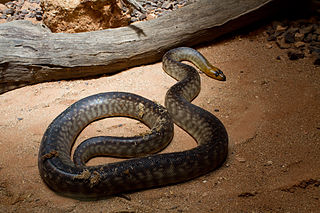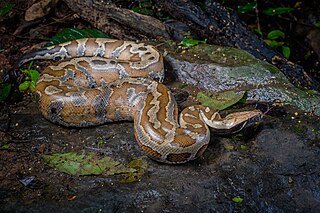
The reticulated python is a python species native to South and Southeast Asia. It is the world's longest snake, and the third heaviest after the green anaconda and Burmese python. It is listed as least concern on the IUCN Red List because of its wide distribution. In several countries in its range, it is hunted for its skin, for use in traditional medicine, and for sale as pets. Due to this, reticulated pythons are one of the most economically important reptiles worldwide.

The ball python, also called the royal python, is a python species native to West and Central Africa, where it lives in grasslands, shrublands and open forests. This nonvenomous constrictor is the smallest of the African pythons, growing to a maximum length of 182 cm (72 in). The name "ball python" refers to its tendency to curl into a ball when stressed or frightened.

Anomochilidae is a family of snakes with one genus, Anomochilus, containing three species of snake. Members of the genus are known as anomochilids, or by the common names dwarf pipesnakes, lesser pipesnakes, and giant blind snakes. Initially created as Anomalochilus in 1890 for the species A. weberi, the genus was renamed in 1901 because the original name was already in use for a genus of beetles. Dwarf pipesnakes are small and cylindrical, with short, conical tails and small, rounded heads that are continuous with the neck. They have blackish to purplish-brown uppersides and dark brown or black undersides, with orange-red bands around the tail and a variety of pale markings on the snout and belly. All three species of dwarf pipesnake are endemic to Sundaland, where they are found on the Malay Peninsula and the islands of Sumatra and Borneo.

The green tree python, is a species of snake in the family Pythonidae. The species is native to New Guinea, some islands in Indonesia, and the Cape York Peninsula in Australia. First described by Hermann Schlegel in 1872, it was known for many years as Chondropython viridis. As its common name suggests, it is a bright green snake that can reach a total length of 2 m (6.6 ft) and a weight of 1.6 kg (3.5 lb), with females slightly larger and heavier than males. Living generally in trees, the green tree python mainly hunts and eats small reptiles and mammals. It is a popular pet, and numbers in the wild have suffered with large-scale smuggling of wild-caught green tree pythons in Indonesia. Despite this, the green tree python is rated as least concern on the IUCN Red List of endangered species.

Morelia spilota, commonly known as the carpet python, is a large snake of the family Pythonidae found in Australia, New Guinea, Bismarck Archipelago, and the northern Solomon Islands. Many subspecies are recognised; ITIS lists six, the Reptile Database six, and the IUCN eight.

The Indian python is a large python species native to tropical and subtropical regions of the Indian subcontinent and Southeast Asia. It is also known by the common names black-tailed python, Indian rock python, and Asian rock python. Although smaller than its close relative the Burmese python, it is still among the largest snakes in the world. It is generally lighter colored than the Burmese python and reaches usually 3 m. Like all pythons, it is nonvenomous.

The Sumatran short-tailed python is a species of the family Pythonidae, a nonvenomous snake native to Sumatra.

Children's python is a species of nonvenomous snake in the family Pythonidae. The species is named after John George Children. It is a nocturnal species occurring in the northern half of Australia and generally found on the ground, although it often climbs trees. Usually growing to about 1.0 m (3 ft) in length or more depending on the polymorphic variant, it is typically a reddish-brown colour, darker on the upper surface, and with many darker blotches, especially on younger specimens. The Stimson's python variant has much stronger and more variable colours; often being adorned with reddish-brown to chocolate blotches against lighter tan. It feeds mostly on small mammals and birds, and as with other pythons, it constricts its prey before swallowing it whole. It is a popular pet among reptile enthusiasts.

The Calabar python is a species of non-venomous snake in the family Boidae. The species is endemic to West and Central Africa. It is the only species in its genus.

The woma python, also known commonly as Ramsay's python, the sand python, and simply the woma, is a species of snake in the family Pythonidae, endemic to Australia. Once common throughout Western Australia, it has become critically endangered in some regions.

The black-headed python is a species of snake in the family Pythonidae. The species is endemic to Australia. There are no subspecies that are recognized as being valid.

The yellow-lipped sea krait, also known as the banded sea krait or colubrine sea krait, is a species of venomous snake found in tropical Indo-Pacific oceanic waters. The snake has distinctive black stripes and a yellow snout, with a paddle-like tail for use in swimming.

Simalia boeleni is a species of python, a nonvenomous snake in the family Pythonidae. The species is endemic to the mountains of New Guinea. No subspecies are recognized. Its common names include Boelen's python and the black python.

Python is a genus of constricting snakes in the Pythonidae family native to the tropics and subtropics of the Eastern Hemisphere.

The amethystine python, also known as the scrub python or sanca permata in Indonesian, is a species of non-venomous snake in the family Pythonidae. The species is found in Indonesia and Papua New Guinea. Popular among reptile enthusiasts, and noted for its coloration and size, it is one of the largest snakes in the world, as measured either by length or weight, and is the largest native snake in Papua New Guinea. Until 2000, the larger S. kinghorni was generally considered a subspecies of S. amethistina, and this change of classification has still not been universally reflected in literature. Because of this issue, S. amethistina has often been described as the largest snake in Australia, but this is not accurate since under the current classification, this species does not occur in Australia.

The rough-scaled python is a large-scaled python species endemic to Australia. No subspecies are currently recognized.

Python brongersmai is a species of nonvenomous snake in the family Pythonidae. The species is native to Southeast Asia.
Olive Griffith Stull (Davis) (February 10, 1905 – June 15, 1969) was an American herpetologist, best known for her work on snakes.

The Australian scrub python, also known commonly as Kinghorn's python and simply as the scrub python is a species of snake in the family Pythonidae. The species is indigenous to forests of northern Australia. It is one of the world's longest and largest snakes, and is the longest and largest in Australia. In 2014 it was reclassified to the genus Simalia alongside a few other former Morelia species, but scientific debate over this continues.






















